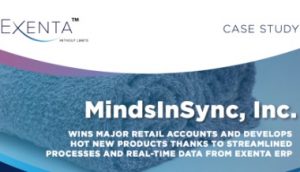Could Your Legacy ERP What’s Holding You Back?
by Roberto Mangual | August 20, 2019

Apparel and soft goods manufacturers relying on legacy ERP face greater risks
It’s no secret that fashion is a rapidly moving and highly competitive industry. In a perfect world, with all of the business data you need and exceptional insight, you’d still have to work hard to read the marketplace and stay ahead of competitors. But with a legacy ERP system as the hub of business, the world is far from perfect. Many legacy ERP systems don’t deliver the necessary data and insight to optimize the business, leading to more business risks, including:
1. Lack of real-time data – Most legacy ERP systems can’t deliver real-time data, especially if your business has international operations or multiple locations. Instead of looking at what is going on in your business right now around the world, you will be presented with backward-looking monthly reports.
2. Isolated data streams – Integrating an application into a legacy ERP system requires extensive programming knowledge to build a proprietary link. Every time you have to install an updated version of your ERP, there’s a chance the integration will break. For this reason, many businesses operate their legacy ERP system without integration into essential applications such as Shop Floor Control (SFC), Warehouse Management (WM) or Product Lifecycle Management (PLM). Isolated data streams prevent consolidated reporting that executives need.
3. Limited reporting for data analysis – The reporting tools inside legacy ERP systems are less robust and less easy to use than today’s business intelligence technology. Legacy database structures didn’t allow for slicing and dicing data as well as modern solutions, and the legacy tools weren’t designed to provide a 30,000 foot view while allowing you to rapidly drill down into granular detail.
4. Spreadsheets and manual data manipulation – Lacking the reporting needed from the legacy ERP system, many professionals turn to spreadsheets. There they try to integrate disparate data streams and manually manipulate the data into a more usable format for decision-making. Unfortunately, it is all too easy to make data entry errors, mistranslate data, or set up incorrect calculations.
5. Strategic gridlock – When executives don’t have enough information to confidently make decisions about the business, one possible outcome is strategic gridlock. The C-suite constantly needs to reach back out to sales, finance and accounting, and operations to request more information. Competitors move forward with strategic initiatives, while you’re stuck at the drawing board.
6. Less informed decision making – As a direct consequence of being frustrated by a lack of real-time information and analysis, some business leaders will simply try to make the best decision they can with the data they’ve got. That is not necessarily the wrong approach, but in today’s rapidly-changing business environment, going down the wrong road—even for a short time—can have disastrous business consequences.
With so many challenges, why do organizations hold onto their legacy systems?
People don’t like to change, and a big change to a mission-critical system like ERP causes more fear and indecision than smaller software adoptions. Even though spreadsheets and manual data manipulation are terribly inefficient and often lead to inaccurate information, it can be hard to let go of a process you have trusted.
Modern, fully-integrated ERP systems open new opportunities
Modernizing the ERP creates big opportunities for improvement within apparel and fashion organizations. Having real-time, reliable information at your fingertips enables your team to spend less time messing with spreadsheets and looking for emails. Instead, they can dive into timely data in order to:
• Discover new insights about demand patterns and customer preferences
• Become a better supply chain partner to suppliers, distributors and retailers
• Develop better products and bring them to market more quickly
• Identify workflow improvements that boost manufacturing efficiency
• Increase on-time order deliveries
• Control production costs and improve workforce utilization
Move legacy ERP out of the way and advance your business goals
Exenta can help you revolutionize your business by providing real time visibility across every aspect of your business—from design to delivery. From concept to cash, we give apparel and soft goods executives the tools to understand everything going on in the business, so they can make faster, better decisions that result in reduced cycle times, unprecedented efficiency gains, and increased profitability. This leads to better partnerships and happier employees—two keys to long-term business success.
Exenta ERP was purpose-built for the fashion and apparel industry, with 700 years of combined experience and apparel-specific expertise supporting its continuous development. Built on next-generation technology, Exenta ERP is a single fully integrated system that gives apparel manufacturers the ability to customize for industry-specific workflows and criteria such as style, color, label, pre-pack and size.
>> Get your free copy of our ERP Software Comparison Guide
To hear how Exenta ERP helped RG Barry Corporation increase productivity and profitability, watch this PLM video. Or, contact us today for a demo and learn how Exenta ERP can transform your manufacturing operations



